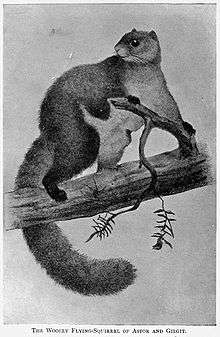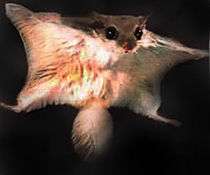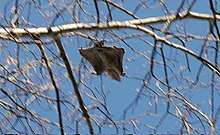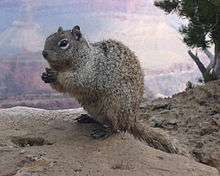Woolly flying squirrel
| Woolly flying squirrel Temporal range: Recent | |
|---|---|
 | |
| Scientific classification | |
| Kingdom: | Animalia |
| Phylum: | Chordata |
| Class: | Mammalia |
| Order: | Rodentia |
| Family: | Sciuridae |
| Tribe: | Pteromyini |
| Genus: | Eupetaurus Thomas, 1888 |
| Species: | E. cinereus |
| Binomial name | |
| Eupetaurus cinereus Thomas, 1888 | |
The woolly flying squirrel (Eupetaurus cinereus) is the sole species placed in the genus Eupetaurus. Until recently scientific knowledge of this rare species was limited to 11 skins collected in the late nineteenth century. However, recent research has confirmed that it remains in Pakistani Kashmir. It is the longest member of the family Sciuridae and the biggest gliding animal known, but observations confirm that despite its size, it does glide effectively like other flying squirrels.
Distribution and description
Eupetaurus has been recorded in northern Pakistan in the area around Gilgit. These areas include Chitral, Astor and Skardu. Other specimens have been purchased from a bazaar in Tibet, collected in Tibet, and collected in Yunnan, China, although the provenience of these is uncertain and no other specimens have ever been found outside Pakistan.[2] Since 1994, specimens have been captured in the Sai Valley, Gorabad, and Balti Gali, all in northern Pakistan.[3] In 2004, the animal was videotaped by Dinets in Raikot Valley near Nanga Parbat, Pakistan. A 2012 study revealed the extension of distributional range of woolly flying squirrel in upper Neelum valley, Azad Jammu & Kashmir.[4] A live specimen captured in this area provided an uncontroversial evidence of its presence in Neelum valley. Sighting and other indirect evidences were also noted at seven different study sites of the area. Neelum valley is adjacent to Northern Areas of Pakistan. The preferred habitat appears to be high elevation conifer forests associated with cliffs and caves.
Its habitat is mainly characterized by steep slopes, difficult to approach cliffs and mixed vegetation including Abies pindrow, Betula utilis, Juniperus macropoda, Pinus wallichiana, Taxus wallichiana, Skimmia laureola, Potentilla eriocarpa, Poa bactriana, Bergenia stracheyi, Artemisia vulgaris, and Bistorta affinis. Habitat degradation due to deforestation and livestock grazing may be the major factors adversely affecting the general habitat in the study area and this species might have negative consequences.[4]
The woolly flying squirrel is very large for a flying squirrel (head and body = 45–60 centimetres (18–24 in)). The cheek teeth are unique as they are both flat-crowned and high crowned (hypsodont), setting Eupetaurus apart from other squirrels and suggesting that it feeds on very abrasive plant material, including pine needles.[5] The animal has fur that is long and thick, with a grizzled pattern that gives the appearance of a woolly pelage, thus the name.
It is listed as an endangered species by the Federal Government of Pakistan.
Relationships
The woolly flying squirrel is unique among the flying squirrels because of its large size and its unique dentition. This led a few early researchers to go so far as to create a distinct family. Some of their arguments were based on poorly drawn and labeled diagrams of the cranium and lower jaw. Zahler and Woods (1997) suggest instead that Eupetaurus is closely related to another genus of large flying squirrels, Petaurista.
Conservation status
The woolly flying squirrel was thought extinct for 70 years until being rediscovered in 2004 by Dr. Peter Zahler, of the Wildlife Conservation Society.[2] The species is currently considered "Endangered" by the International Union for the Conservation of Nature.[6]
References
- ↑ Molur, S. (2008). "Eupetaurus cinereus". IUCN Red List of Threatened Species. Version 2008. International Union for Conservation of Nature. Retrieved 6 January 2009.
- 1 2 "Lost & Found - Once upon a time, there was an adventurer". lostandfoundnature.com/. Retrieved 2018-04-08.
|first1=missing|last1=in Authors list (help) - ↑ Zahler and Woods, 1997
- 1 2 Qamar et al., 2012
- ↑ Zahler and Khan, 2003
- ↑ "Eupetaurus cinereus (Woolly Flying Squirrel)". www.iucnredlist.org. Retrieved 2018-04-08.
- Din, J. Ud., Khan, M., Ghaznavi, M., Shah, K. A., Younus, M. (2015) Note on the Giant Woolly Gliding Squirrel Eupetaurus cinereus (Mammalia: Rodentia: Sciuridae) in northern Pakistan. Journal of Threatened Taxa 7(9): 7602-7604; http://threatenedtaxa.org/index.php/JoTT/article/view/2190/3299
- Qamar, Z. Q., Ali, U., Minhas, R. A., Dar, N. I. and Anwar, M. (2012). New Distribution Information on Woolly Flying Squirrel (Eupetaurus cinereus Thomas, 1888) in Neelum Valley of Azad Jammu and Kashmir, Pakistan. Pakistan Journal of Zoology, 44(5): 1333-1342.
- Dinets, V. (2011). Observations of woolly flying squirrel (Eupetaurus cinereus) in Nanga Parbat Range of northern Pakistan. Mammalia 75(3): 277-280.
- Zahler, P. (1996). Rediscovery of the woolly flying squirrel (Eupetaurus cinereus). Journal of Mammalogy 77: 54-57.
- Zahler, P. (2001). The woolly flying squirrel and gliding: does size matter? Acta Theriologica 46: 429-435.
- Zahler, P. and M. Khan. (2003). Evidence for dietary specialization on pine needles by the woolly flying squirrel (Eupetaurus cinereus). Journal of Mammalogy, 84(2): 480-486.
- Zahler, P. and C. A. Woods. (1997). The status of the woolly flying squirrel (Eupetaurus cinereus) in Northern Pakistan. pp 495–514 in Biodiversity of Pakistan (S. A. Mufti, C. A, Woods, and S. A. Hasan eds.). Pakistan Museum of Natural History, Islamabad.





.jpg)